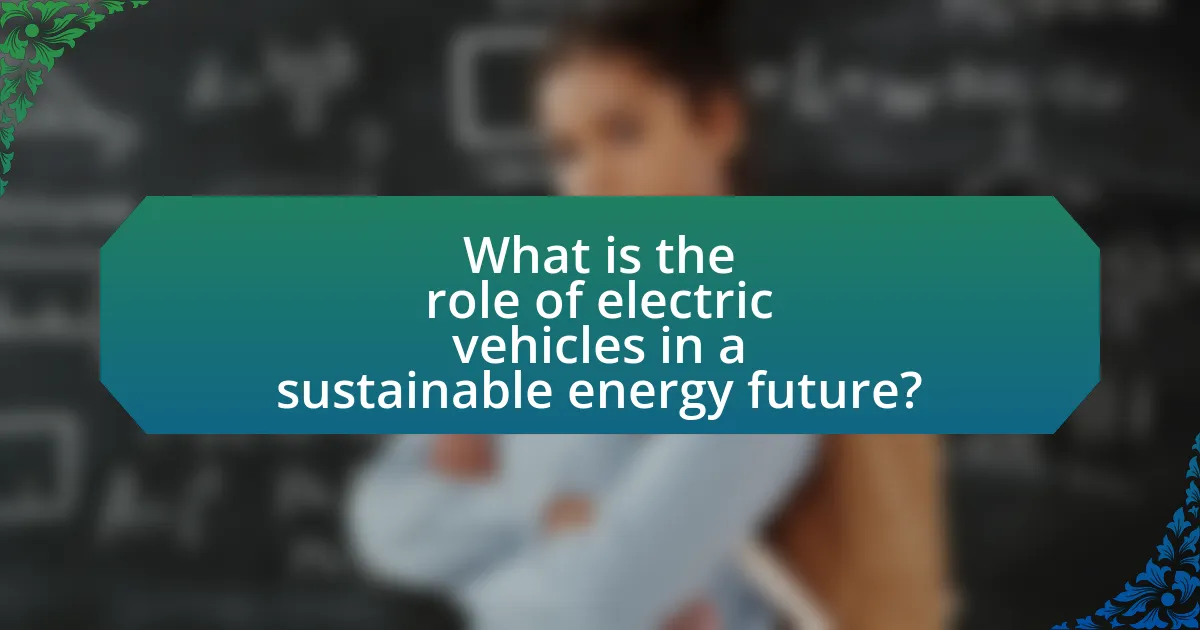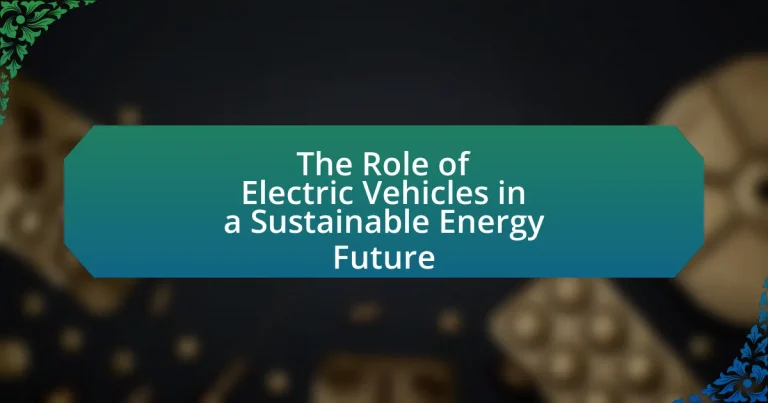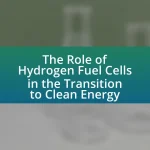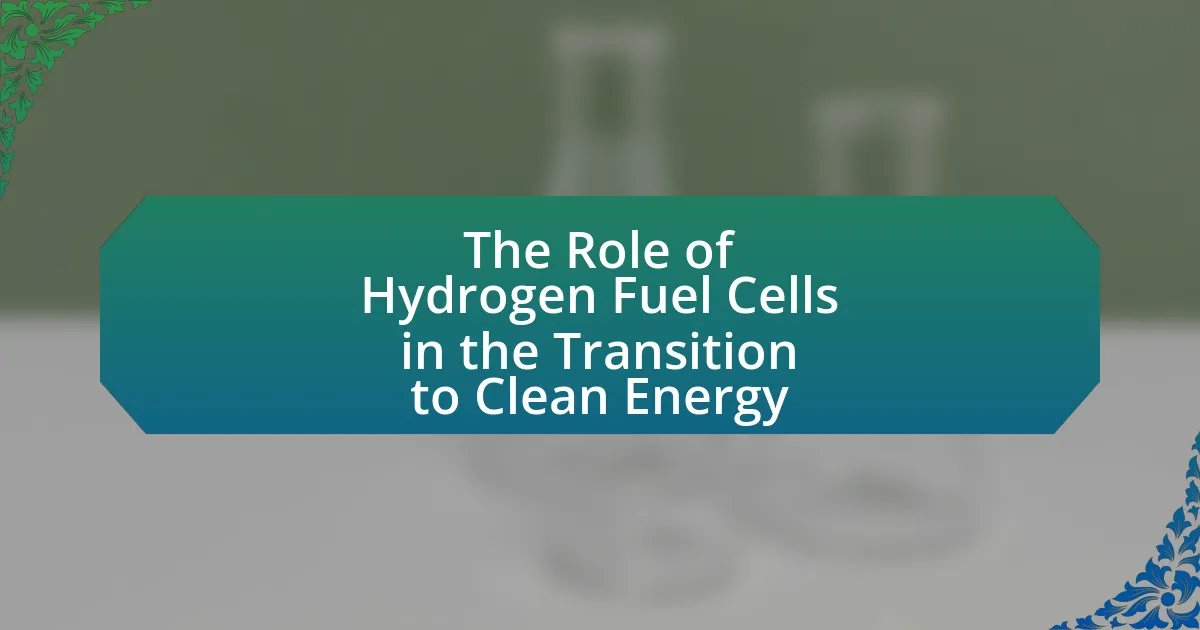Electric vehicles (EVs) are pivotal in advancing a sustainable energy future by significantly reducing greenhouse gas emissions and reliance on fossil fuels. They produce zero tailpipe emissions, contributing to improved air quality, and their adoption could potentially lower global CO2 emissions by up to 1.5 gigatons annually by 2030. The article explores how EVs enhance energy efficiency, support the transition to renewable energy sources, and contribute to grid stability while addressing challenges such as battery production and charging infrastructure. Additionally, it discusses the economic implications of widespread EV adoption, including cost savings for consumers and job creation in the green technology sector, alongside policies that can facilitate their integration into a sustainable energy strategy.

What is the role of electric vehicles in a sustainable energy future?
Electric vehicles (EVs) play a crucial role in a sustainable energy future by reducing greenhouse gas emissions and reliance on fossil fuels. EVs produce zero tailpipe emissions, which significantly lowers air pollution in urban areas. According to the International Energy Agency, the widespread adoption of EVs could reduce global CO2 emissions by up to 1.5 gigatons annually by 2030. Additionally, as the electricity grid transitions to renewable energy sources, the overall carbon footprint of EVs continues to decrease, further enhancing their environmental benefits. This shift not only supports climate goals but also promotes energy independence and security by decreasing dependence on oil imports.
How do electric vehicles contribute to reducing greenhouse gas emissions?
Electric vehicles (EVs) contribute to reducing greenhouse gas emissions primarily by eliminating tailpipe emissions, which are a significant source of carbon dioxide and other pollutants from traditional gasoline and diesel vehicles. According to the U.S. Environmental Protection Agency, transportation accounts for approximately 29% of total greenhouse gas emissions in the United States, with light-duty vehicles being a major contributor. By replacing internal combustion engines with electric drivetrains, EVs significantly decrease the direct emissions associated with driving.
Furthermore, when powered by renewable energy sources, such as wind or solar, the overall lifecycle emissions of EVs can be substantially lower than those of conventional vehicles. A study by the Union of Concerned Scientists found that, on average, EVs produce less than half the emissions of comparable gasoline-powered vehicles over their lifetime, even when accounting for emissions from electricity generation. This demonstrates that the transition to electric vehicles is a crucial step in mitigating climate change and promoting a sustainable energy future.
What are the specific emissions reductions associated with electric vehicles?
Electric vehicles (EVs) can reduce greenhouse gas emissions by approximately 50% to 70% compared to conventional gasoline vehicles. This reduction is primarily due to the absence of tailpipe emissions and the potential for cleaner electricity sources. For instance, a study by the Union of Concerned Scientists found that, on average, EVs produce less than half the emissions of comparable gasoline-powered cars over their lifetime, even when accounting for emissions from electricity generation. Additionally, as the energy grid becomes increasingly powered by renewable sources, the emissions associated with EVs will continue to decrease, further enhancing their environmental benefits.
How do electric vehicles compare to traditional vehicles in terms of emissions?
Electric vehicles (EVs) produce significantly lower emissions compared to traditional internal combustion engine vehicles. While traditional vehicles emit greenhouse gases and pollutants during operation, EVs generate zero tailpipe emissions. According to the U.S. Environmental Protection Agency, the average gasoline vehicle emits about 404 grams of CO2 per mile, whereas EVs, depending on the electricity source, can have a much lower carbon footprint. For instance, when charged from renewable energy sources, EVs can achieve near-zero emissions, highlighting their potential to reduce overall air pollution and contribute to climate change mitigation.
Why are electric vehicles considered essential for energy sustainability?
Electric vehicles are considered essential for energy sustainability because they significantly reduce greenhouse gas emissions and reliance on fossil fuels. By utilizing electricity, particularly from renewable sources like solar and wind, electric vehicles contribute to a cleaner energy ecosystem. According to the International Energy Agency, transitioning to electric vehicles could reduce global CO2 emissions by up to 1.5 gigatons annually by 2030, highlighting their potential impact on climate change mitigation. Furthermore, electric vehicles enhance energy efficiency, as they convert over 60% of the electrical energy from the grid to power at the wheels, compared to conventional gasoline vehicles that only convert about 20% of the energy stored in gasoline. This efficiency, combined with the ability to integrate with renewable energy systems, underscores the critical role electric vehicles play in achieving energy sustainability.
What role do electric vehicles play in the transition to renewable energy sources?
Electric vehicles (EVs) significantly contribute to the transition to renewable energy sources by reducing greenhouse gas emissions and enhancing energy efficiency. EVs operate on electricity, which can be generated from renewable sources such as solar, wind, and hydroelectric power, thereby decreasing reliance on fossil fuels. According to the International Energy Agency, the adoption of EVs could lead to a reduction of up to 1.5 gigatons of CO2 emissions by 2030 if paired with a clean energy grid. This shift not only lowers emissions but also promotes the integration of renewable energy into the transportation sector, facilitating a more sustainable energy future.
How do electric vehicles support energy grid stability and efficiency?
Electric vehicles (EVs) support energy grid stability and efficiency by acting as flexible energy storage systems that can absorb excess energy during low demand and supply energy back to the grid during peak demand. This bidirectional energy flow helps balance supply and demand, reducing the risk of grid overloads and blackouts. For instance, studies show that integrating EVs into the grid can enhance demand response capabilities, allowing utilities to manage energy loads more effectively. According to a report by the International Energy Agency, widespread EV adoption could lead to a 30% reduction in peak electricity demand by 2040, demonstrating their potential to improve grid efficiency and reliability.
What challenges do electric vehicles face in achieving a sustainable future?
Electric vehicles (EVs) face several challenges in achieving a sustainable future, primarily related to battery production, charging infrastructure, and resource availability. The production of lithium-ion batteries, essential for EVs, involves significant environmental impacts, including mining practices that can lead to habitat destruction and pollution. Additionally, the current charging infrastructure is insufficient in many regions, limiting the practicality of EVs for long-distance travel and daily use. Furthermore, the availability of critical materials, such as lithium, cobalt, and nickel, is constrained by geopolitical factors and supply chain issues, which can hinder the scalability of EV production. These challenges must be addressed to ensure that electric vehicles contribute effectively to a sustainable energy future.
What are the current limitations of electric vehicle technology?
The current limitations of electric vehicle technology include limited driving range, long charging times, high battery costs, and insufficient charging infrastructure. Limited driving range affects consumer confidence, as many electric vehicles typically offer between 150 to 370 miles on a single charge, which is less than the range of many gasoline vehicles. Long charging times can take anywhere from 30 minutes at fast chargers to several hours at home, making it less convenient for users. High battery costs, which account for approximately 30% of the total vehicle cost, hinder affordability and widespread adoption. Additionally, the charging infrastructure remains inadequate, with only about 100,000 public charging stations in the U.S. as of 2023, limiting accessibility for potential users.
How do infrastructure and charging station availability impact electric vehicle adoption?
Infrastructure and charging station availability significantly influence electric vehicle (EV) adoption by addressing range anxiety and enhancing convenience for users. A robust network of charging stations reduces concerns about running out of battery power, making potential buyers more likely to consider EVs. According to a study by the International Council on Clean Transportation, regions with higher charging infrastructure density see a 20% increase in EV sales compared to areas with limited access. This correlation demonstrates that adequate charging facilities not only facilitate the practical use of electric vehicles but also encourage consumer confidence, ultimately driving higher adoption rates.
How can electric vehicles be integrated into a broader sustainable energy strategy?
Electric vehicles can be integrated into a broader sustainable energy strategy by aligning their use with renewable energy sources and smart grid technologies. This integration allows for the charging of electric vehicles during periods of high renewable energy generation, such as solar and wind, thereby reducing reliance on fossil fuels. For instance, studies show that charging electric vehicles with renewable energy can decrease greenhouse gas emissions by up to 70% compared to conventional vehicles. Additionally, vehicle-to-grid technology enables electric vehicles to return energy to the grid during peak demand, enhancing grid stability and efficiency. This synergy between electric vehicles and renewable energy systems supports a transition to a low-carbon economy and promotes energy resilience.
What are the economic implications of widespread electric vehicle adoption?
Widespread electric vehicle adoption has significant economic implications, including reduced dependence on fossil fuels and potential job creation in the green technology sector. The transition to electric vehicles can lower fuel costs for consumers, as electricity is generally cheaper than gasoline, leading to increased disposable income. According to the International Energy Agency, electric vehicles could save consumers up to $1.7 trillion in fuel costs by 2030. Additionally, the growth of the electric vehicle market is expected to create millions of jobs in manufacturing, infrastructure development, and maintenance, with a projected 10 million jobs in the electric vehicle sector by 2030, as reported by the World Economic Forum. Furthermore, widespread adoption can stimulate investments in renewable energy sources, enhancing energy security and contributing to economic growth.
How do electric vehicles affect job creation in the automotive and energy sectors?
Electric vehicles (EVs) positively impact job creation in both the automotive and energy sectors by driving demand for new manufacturing processes and technologies. The transition to EVs requires specialized skills in battery production, electric drivetrains, and software development, leading to the creation of jobs in manufacturing plants and research facilities. For instance, a report by the International Council on Clean Transportation indicates that the shift to EVs could create over 1 million jobs in the U.S. automotive sector by 2030, particularly in areas related to battery manufacturing and assembly. Additionally, the energy sector sees job growth through the expansion of charging infrastructure and renewable energy sources needed to power EVs, with the U.S. Department of Energy estimating that investments in EV infrastructure could generate hundreds of thousands of jobs in installation and maintenance.
What are the potential cost savings for consumers using electric vehicles?
Consumers can save significantly on fuel and maintenance costs by using electric vehicles (EVs). Electric vehicles typically have lower operating costs compared to gasoline-powered cars, with electricity costing about half as much per mile as gasoline. For instance, the U.S. Department of Energy reports that the average cost to drive an electric vehicle is around $0.04 per mile, while gasoline vehicles average about $0.12 per mile. Additionally, EVs have fewer moving parts, leading to reduced maintenance expenses; studies indicate that maintenance costs for electric vehicles can be 30-50% lower than for traditional vehicles. These factors contribute to substantial long-term savings for consumers who choose electric vehicles.
What best practices can enhance the role of electric vehicles in sustainability?
Implementing renewable energy sources for charging electric vehicles significantly enhances their role in sustainability. By utilizing solar, wind, or hydroelectric power, the carbon footprint associated with electricity generation is reduced, making electric vehicles more environmentally friendly. For instance, a study by the International Energy Agency indicates that charging electric vehicles with renewable energy can cut greenhouse gas emissions by up to 70% compared to conventional fossil fuel sources. Additionally, promoting energy-efficient charging infrastructure, such as smart grids and fast-charging stations, can optimize energy use and reduce peak demand, further supporting sustainability goals.
How can consumers maximize the benefits of electric vehicles?
Consumers can maximize the benefits of electric vehicles by utilizing charging incentives, participating in demand response programs, and maintaining their vehicles properly. Charging incentives, such as time-of-use rates, allow consumers to charge their vehicles during off-peak hours, reducing electricity costs. Demand response programs enable consumers to receive financial rewards for reducing energy consumption during peak demand times, which can further lower overall energy expenses. Proper maintenance, including regular software updates and battery care, ensures optimal performance and longevity of electric vehicles, enhancing their efficiency and cost-effectiveness. Studies show that consumers who engage in these practices can save significantly on energy costs and extend the lifespan of their vehicles, thereby maximizing the overall benefits of electric vehicle ownership.
What policies can governments implement to support electric vehicle adoption?
Governments can implement various policies to support electric vehicle (EV) adoption, including financial incentives, infrastructure development, and regulatory measures. Financial incentives such as tax credits, rebates, and grants can lower the upfront costs of EVs, making them more accessible to consumers. For instance, the U.S. federal tax credit offers up to $7,500 for eligible electric vehicles, significantly encouraging purchases.
Infrastructure development is crucial; governments can invest in charging station networks to alleviate range anxiety among potential EV buyers. According to the International Energy Agency, a robust charging infrastructure is essential for achieving a significant increase in EV adoption rates.
Regulatory measures, such as setting emissions standards and implementing low-emission zones, can further drive the transition to electric vehicles. For example, California’s Advanced Clean Cars Program aims to increase the number of zero-emission vehicles on the road, demonstrating how regulations can shape consumer behavior and industry practices.
These policies collectively create a supportive environment for electric vehicle adoption, facilitating a transition towards a more sustainable energy future.




